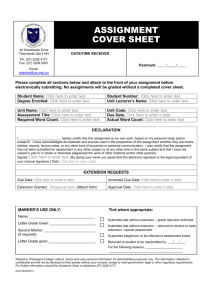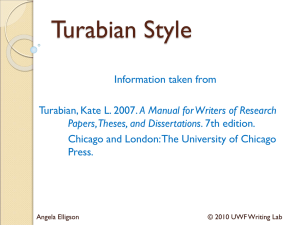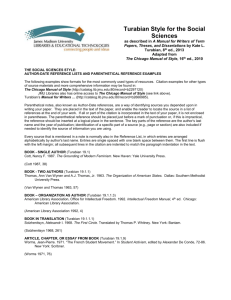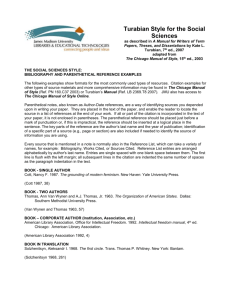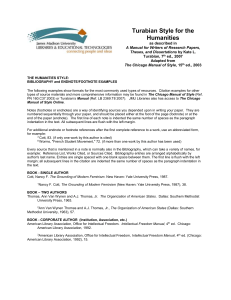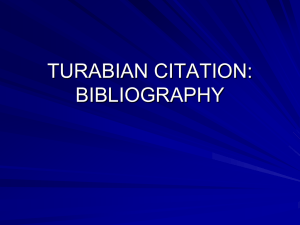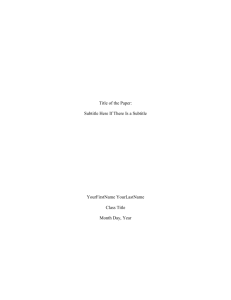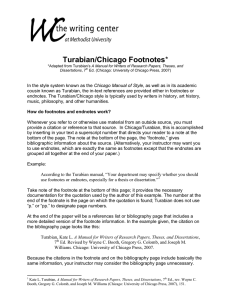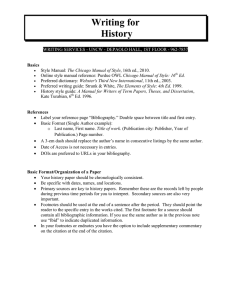WCU Writing and Learning Commons (WaLC) Turabian- Research Documentation 8th Edition
advertisement
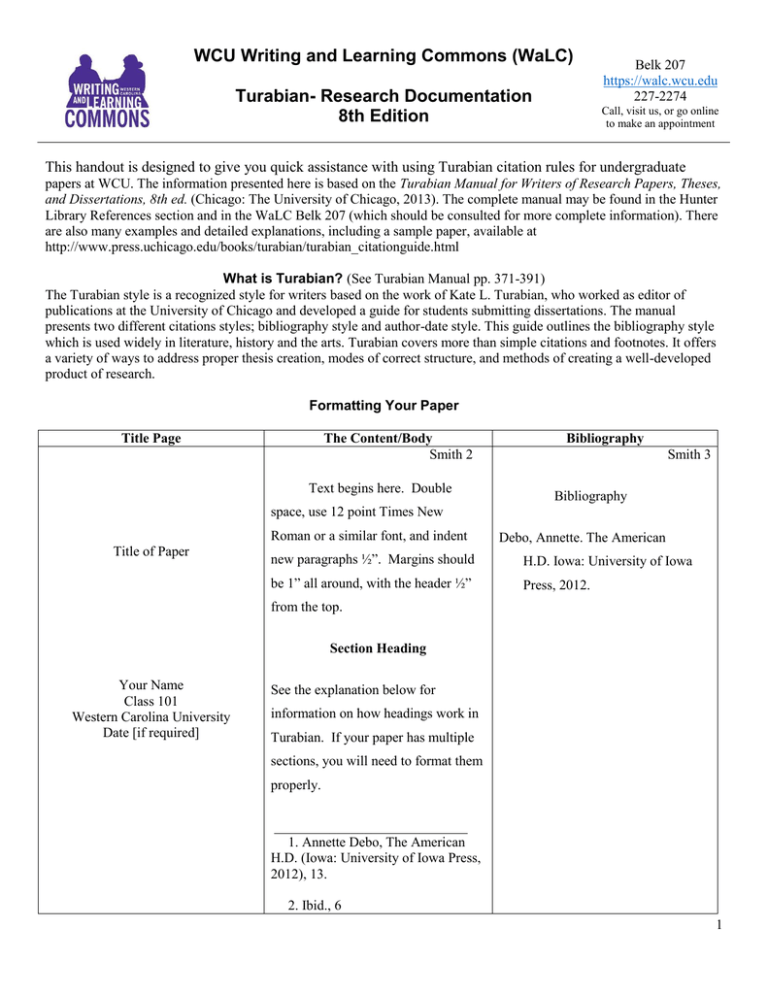
WCU Writing and Learning Commons (WaLC) Turabian- Research Documentation 8th Edition Belk 207 https://walc.wcu.edu 227-2274 Call, visit us, or go online to make an appointment This handout is designed to give you quick assistance with using Turabian citation rules for undergraduate papers at WCU. The information presented here is based on the Turabian Manual for Writers of Research Papers, Theses, and Dissertations, 8th ed. (Chicago: The University of Chicago, 2013). The complete manual may be found in the Hunter Library References section and in the WaLC Belk 207 (which should be consulted for more complete information). There are also many examples and detailed explanations, including a sample paper, available at http://www.press.uchicago.edu/books/turabian/turabian_citationguide.html What is Turabian? (See Turabian Manual pp. 371-391) The Turabian style is a recognized style for writers based on the work of Kate L. Turabian, who worked as editor of publications at the University of Chicago and developed a guide for students submitting dissertations. The manual presents two different citations styles; bibliography style and author-date style. This guide outlines the bibliography style which is used widely in literature, history and the arts. Turabian covers more than simple citations and footnotes. It offers a variety of ways to address proper thesis creation, modes of correct structure, and methods of creating a well-developed product of research. Formatting Your Paper Title Page The Content/Body Smith 2 Text begins here. Double Bibliography Smith 3 Bibliography space, use 12 point Times New Roman or a similar font, and indent Title of Paper Debo, Annette. The American new paragraphs ½”. Margins should H.D. Iowa: University of Iowa be 1” all around, with the header ½” Press, 2012. from the top. Section Heading Your Name Class 101 Western Carolina University Date [if required] See the explanation below for information on how headings work in Turabian. If your paper has multiple sections, you will need to format them properly. ____________________________ 1. Annette Debo, The American H.D. (Iowa: University of Iowa Press, 2012), 13. 2. Ibid., 6 1 The Title Page (See Turabian Manual p. 376) A title page in Turabian should include a title, your name, and the class (and/or university) for which you wrote the paper. Some professors may ask you to include the date. Make sure that the title of your work is placed in the middle and your name, class, etc. is located several spaced down from the title. (See example) More detailed page formats may be found in Turabian Manual for Writers of Research Papers, Theses, and Disertations, 8th ed. Note: Some professors might not require a title page. On the first page, put your full name, professor’s name, class, and date in the left margin. After that, put the title, centered, before you start your main text. Make sure all of this is double-spaced. The Abstract (See Turabian Manual p. 389) An abstract is a summary of your paper. For most undergraduate papers, abstracts are not required. Ask your professor whether to include one. If you are required to write an abstract, it should appear on the second page and be 150 to 250 words in length. For more information, consult the Turabian Manual for Writers of Research Papers, Theses, ad Dissertations, 8th ed. or visit the WaLC. The Content/Body Text begins after the title page. All paragraphs must be indented ½ “. The paper should be double spaced, 12 pt. Times New Roman font with 1” margins. Each page of your paper should have a page number and should follow Manual for Writers of Research Papers, Theses, and Dissertations, 8th ed. formatting rules for headings, tables, etc. Headings Note that the header on the title page is not the same as the header in the rest of the paper. Headings are not commonly used in Turabian papers so ask your professor about their preference. Tables and Figures (See Turabian Manual pp. 358-369) Turabian has very specific rules for visuals and tabulated data. For information regarding the design and the proper citation of tables, figures, or any other visual elements in your paper, refer to the section titled “Tables and Graphs” in the 7th edition of the Manual for Writers of Research Papers, Theses, and Dissertations. 2 Rules for Turabian Source List (Works Cited or Bibliography) NOTE: Good research requires you to select your sources carefully and read them closely. Start by finding reliable, relevant sources. Develop an understanding of your topic, build your source list, and then start writing. Remember, the research always comes first! All sources should be included in a list at the end of your paper. Typically, for electronic sources presented on a web page, Turabian does not have a preference on the use of URLs over DOIs. One is necessary though. (See Turabian Manual p. 141) Retrieval dates are required for all e-journals, web pages, video files, and any other electronic resource. However; instead of using the phrase “retrieved,” the Turabian guide uses “Accessed.” (See Turabian Manual p. 140, 182) Turabian follows headline capitalization style for titles, except in foreign languages. (See Turabian Manual p. 169, 312) In-text citations following the parenthetical style in Turabian require a minimum of the author’s first and last name and page number. Example: (James Joyce, 35) If only citing one source, it can just use the page number. (See Turabian Manual p. 226) In cases where there are multiple authors, Turabian requires that there be more than three authors before converting to et al. (See Turabian Manual p. 218) When citing the publisher, omit the following words from the works cited or bibliographic entry: The, Inc., S.A., Ltd., Co., & Co., and Publishing Co. The publishing company, city, and date are required. (See Turabian Manual p. 175, 241) o Example: Chicago: University of Chicago Press, 2008. When citing from a database, a URL based on a DOI is preferred. If no stable URL is available, the citation should include the name of the database after the date accessed, taking the place of a URL or DOI. (See Turabian Manual p. 141) o Example: Lepage, Mark. “Armageddon, Apocalypse, the Rapture: People Have Been Predicting the End since the Beginning.” Gazette (Montreal), May 21, 2011. Accessed December 20, 2012, LexisNexis Academic. The Bibliography should always be done in alphabetical order. However, if using endnotes, the endnote page(s) should follow numerical order. (See Turabian Manual p. 151) If the author’s first name is given in full, it should be used in the citation. If there is a question about the first name, put the name as it appears in the source, whether initialed or spelled in full. (See Turabian Manual p. 222) Sources: Scholarly sources are easier to cite than informal ones. If you are having trouble with a citation, look for a more reputable source. For any academic paper, use library resources. Don't just "Google" your topic. 3 Footnotes and Endnotes (See Turabian Manual pp. 155-161) In this handout, the format for a footnote or endnote is listed beside N. Indicate research material in the text of your paper using MS Word’s Insert/Reference/Footnote function to place a superscript number outside the final period of a summary or paraphrase. For direct quotations, place the superscript number outside the final quotations marks. According to the 8th edition Turabian Manual, the number that precedes the footnote/endnote is NOT formatted in superscript and is followed by a period. After you have inserted the superscript number in your text, delete Word’s default superscript number in the corresponding footnote/endnote box, and type in the appropriate number followed by a period. The first line of a footnote/endnote is indented five spaces, or one tab space, and each subsequent line is flush with the left-hand margin. The name of the author is not reversed and is separated from the title of the author’s text by a comma rather than a period. There is no punctuation between the title and the publishing information. Footnote/endnote numbers are sequential throughout the paper. Footnotes appear at the bottom of the page. Endnotes appear on a page entitled Endnotes at the end of the paper before the Bibliography. In this handout, the format for a bibliography entry is listed beside B. At the top of your bibliography page, center the word Bibliography, and then double-space to start your first entry. Each entry is listed in alphabetical order by the author’s last name. The first line of each entry is flush with the left-hand margin, and each subsequent line is indented 1/2 inch. Use MS Word’s Ruler or Format Paragraph functions to set a hanging indent. Different elements of an entry are separated by periods, followed by one space. Single-space entries, but double-space between entries. Subsequent Notes When references to the same work follow one another with no intervening references, even if several pages separate them, ibid. may take the place of the author’s name, the title of the work, and as much of the succeeding material as is identical, including the page number. If, however, the page number changes, the new number must be included with ibid. The author’s name and the title are never used with ibid. 1. Max Plowman, An Introduction to the Study of Blake (London: Gollancz, 1982), 32. 2. Ibid. 3. Ibid., 68. NOTE: Ibid. is neither underlined nor italicized. 4 References to a work that has already been cited in full form, but not in a note immediately preceding it, should be cited by using the author’s last name, title of book, chapter, or article (shortened if necessary); and specific page reference. 1. Max Plowman, Introduction to the Study of Blake (London: Gollancz, 1952), 58-59. 4. Plowman, Study of Blake, 125. An Exception to the Footnote Rule (check with your professor before using) Some WCU history professors prefer a single superscript at the end of a paragraph with a corresponding footnote containing multiple sources, rather than multiple superscripts scattered throughout one paragraph followed by multiple footnotes at the bottom of the page. This practice is particularly useful in paragraphs where multiple sources provide overlapping information. The two examples below come from “Flaunting the Freak Flag: Karr v. Schmidt and the Great Hair Debate in American High Schools, 1965-1975,” by WCU’s Gael Graham: N. 8. Jones v. Day, 127 Miss.136 (1921); Pugsley v. Sellmeyer, 158 Ark. 247 (1923); Palladino, Teenagers, 162; Arlene S. Skolnick, Embattled Paradise: The American Family in an Age of Uncertainty (New York, 1991); James Burkhart Gilbert, A Cycle of Outrage: American’s Reaction to the Juvenile Delinquent in the 1950s (New York, 1986), 16; Board of Education, Buffalo, New York, School-Community Coordination, “Recommendations of the Inter-High School Student Council for Appropriate Dress of Students in High School,” in American Record, ed. Graebner and Richards, II, 320-21. N. 11. Tinker v. Des Moines, 393 U.S. at 503. On high school press freedom, see Shanley v. Northeast Independent School District, 462 F.2d 960 (1972); Quarterman v. Byrd, 453 F.2d (1971); and Scoville v. Board of Education of Joliet Township High School District, 425 F.2d 10 (1970). Student political expression was handled in Guzick v. Drebus, 305 F. Supp. 472 (1969). Due process in high school discipline was established in Goss v. Lopez, 419 U.W. 565 (1975). 5 Bibliographic Entries Below are the basic formats and examples of sources often used in research papers. Books (See Turabian Manual pp. 165-181) Books by a single author N. 1. Annette Debo, The American H.D. (Iowa City: University of Iowa Press,2012), 54. NOTE: The abbreviation “p.” is normally omitted before a page number, but do include “p.” if it prevents confusion. B. Debo, Annette. The American H.D. Iowa City: University of Iowa Press, 2012. Books by two or three authors N. 2. Laura Wright and Elizabeth Heffelfinger, Visual Difference: Postcolonial Studies and Intercultural Cinema. (New York: Peter Lang, 2010), 12. B. Wright, Laura, and Elizabeth Heffelfinger, Visual Difference: Postcolonial Studies and Intercultural Cinema. New York: Peter Lang, 2010. Books by more than three authors N. 3. Diane Martinez et al., Technical Writing: A Comprehensive Resource for Technical Writers at All Levels, 2nd. Ed.(New York: Kaplan, 2010), 45. B. Martinez, Diane, et al. Technical Writing: A Comprehensive Resource for Technical Writers at All Levels, 2nd. Ed. New York: Kaplan, 2010. Books by organization as author N. 4. American Library Association, Young Adult Services Division, Services Statement Development Committee, Directions for Library Service to Young Adults (Chicago: American Library Association, 1978), 25. B. American Library Association. Young Adult Services Division, Services Statement Development Committee. Directions for Library Service to Young Adults. Chicago: American Library Association, 1978. Anonymous books N. B. 5. The Lottery (London: J. Watts, [1732]), 20-25. The Lottery. London: J. Watts, [1732]. Later editions of books N. 6. M. M. Bober, Karl Marx’s Interpretation of History, 2nd ed. Harvard Economic Studies (Cambridge: Harvard University Press, 1948), 89. B. Bober, M. M. Karl Marx’s Interpretation of History, 2nd ed. Harvard Economic Studies. Cambridge: Harvard University Press, 1948. 6 Parts of a single author books If you are citing the author N. 7. John Charles Chasteen, “Neocolonialism,” in Born in Blood and Fire: A Concise History of Latin America (New York: W.W. Norton & Company, 2001), 190-91. B. Chasteen, John Charles. “Neocolonialism.” In Born in Blood and Fire: A Concise History of Latin America, 179206. New York: W. W. Norton & Company, 2001. If you are citing the author of a preface, forward, or introduction N. 8. Craig Calhoun, foreword to Multicultural Politics: Racism, Ethnicity, and Muslims in Britain, by Tariq Modood (Minneapolis: University of Minnesota Press, 2005), xvi. B. Calhoun, Craig. Foreword to Multicultural Politics: Racism, Ethnicity, and Muslims in Britain, by Tariq Modood. Minneapolis: University of Minnesota Press, 2005. Edited books with selections by different authors If you are citing the editor N. B. 9. Robert von Hallberg, ed., Canons (Chicago: University of Chicago Press, 1984), 225. von Hallberg, Robert, ed. Canons. Chicago: University of Chicago Press, 1984. If you are citing an author N. 10. Mary Higdon Beech, “The Domestic Realm in the Lives of Hindu Women in Calcutta,” in Separate Worlds: Studies of Purdah in South Asia, ed. Hanna Papanek and Gail Minault (Delhi: Chanakya, 1982), 115. B. Beech, Mary Higdon. “The Domestic Realm in the Lives of Hindu Women in Calcutta.” In Separate Worlds: Studies of Purdah in South Asia, edited by Hanna Papanek and Gail Minault, 110-38. Delhi: Chanakya, 1982. Multivolume works N. 11. Ellen Pollak, The Poetics of Sexual Myth: Gender and Ideology in the Verse of Swift and Pope, Women in Culture and Society (Chicago: University of Chicago Press, 1985), 124. B. Pollak, Ellen. The Poetics of Sexual Myth: Gender and Ideology in the Verse of Swift and Pope. Women in Culture and Society. Chicago: University of Chicago Press, 1985. Multivolumes with a different author and title for each N. 12. Gordon N. Ray, ed., An Introduction to Literature, vol. 2 of The Nature of Drama, by Hubert Hefner, (Boston: Houghton Mifflin Co., 1959), 47-49. B. Ray, Gordon N., ed. An Introduction to Literature. Vol. 2 of The Nature of Drama, by Hubert Hefner. Boston: Houghton Mifflin, 1959. Author’s work contained in collected works titled with author’s name N. 13. The Complete Works of Samuel Taylor Coleridge, ed. W. G. T. Shedd, vol. 1 of Aids to Reflection (New York: Harper & Bros., 1884), 18. 7 B. Coleridge, Samuel Taylor. The Complete Works of Samuel Taylor Coleridge. Edited by W. G. T. Shedd. Vol. 1 of Aids to Reflection. New York: Harper & Bros., 1884. Articles in encyclopedias or other reference works 14. Encyclopaedia Britannica, 15th ed., s.v. “Salvation.” N. NOTE: Well-known reference books are generally not listed in bibliographies. In the footnote/endnote, the facts of publication are usually omitted, but the edition, if not the first, must be specified; “s.v.” stands for “under the word” and is used in citations for encyclopedias and dictionaries. If the reference book is not well known, include a bibliographic entry as well as a footnote/endnote with publication details. N. 15. The Times Guide to English Style and Usage, rev. ed. (London: Times Books, 1999), s.v.v. “police ranks,” “postal addresses.” B. Aulestia, Gorka. Basque English Dictionary. Reno: University of Nevada Press, 1989. Author’s work translated or edited by another N. 16. Dorothy Allison, Conversations with Dorothy Allison, Ed. Mae Miller Claxton (Jackson, MS : University Press of Mississippi, 2012), 86. B. Allison, Dorothy. Conversations with Dorothy Allison. Edited by Mae Miller Claxton. Jackson, MS : University Press of Mississippi, 2012 One source quoted in another N. 17. Louis Zukofsky, “Sincerity and Objectification,” Poetry 37 (February 1931): 269, quoted in Bonnie Costello, Marianne Moore: Imaginary Possessions (Cambridge: Harvard University Press, 1981), 78. B. Zukofsky, Louis. “Sincerity and Objectification.” Poetry 37 (February 1931): 269. Quoted in Bonnie Costello, Marianne Moore: Imaginary Possessions Cambridge: Harvard University Press, 1981. Periodical Articles (See Turabian Manual pp. 182-187) Magazines N. 18. Keith Brenton “Winning numbers: A casino VP is Recognized as a Top Native American Young Professional,” Western Carolina Magazine, April 26, 2013, 39. B. Brenton, Keith. “Winning numbers: A casino VP is Recognized as a Top Native American Young Professional,” Western Carolina Magazine, April 26, 2013, 39. NOTE: For unsigned articles, begin with the article title. Articles in journals with continuous pagination throughout annual volumes N. 19. Richard Jackson, “Running down the Up-Escalator: Regional Inequality in Papua New Guinea,” Australian Geographer 14 (May 1979): 180. B. Jackson, Richard. “Running down the Up-Escalator: Regional Inequality in Papua New Guinea.” Australian Geographer 14 (May 1979): 175-84. 8 Articles in journals with separate pagination for each issue N. 19. Brian Gastle. “Breaking the Stained Glass Ceiling: Mercantile Authority, Margaret Paston and Margery Kempe.” Studies in the Literary Imagination 36 (Spring 2003):123-147. B. Gastle, Brian. “Breaking the Stained Glass Ceiling: Mercantile Authority, Margaret Paston and Margery Kempe.” Studies in the Literary Imagination 36 (Spring 2003): 123-147. Signed articles in newspapers N. 21. Casey Blake, “State to Close Asheville Abortion Clinic: Clinic's License Suspended for Safety Violations.” Asheville Citizen-Times, July 31, 2013. NOTE: According to Turabian, news items from daily papers are rarely listed separately in a bibliography or reference list. If a newspaper is cited only once or twice, a footnote or endnote is sufficient. If the article is frequently cited or important to your argument, also include a bibliographic entry. B. Blake, Casey. “State to Close Asheville Abortion Clinic: Clinic’s License Suspended for Safety Violations.” Asheville Citizen-Times, July 31, 2013. Printed book reviews N. 22. Laura Cruz, 2013, review of Taxation and Debt in the Early Modern City, by J.I.Andrés Ucendo and M.Limberger, eds, Economic History Review, 66, no.2: 672-673. B. Cruz, Laura. 2013. Review of Taxation and Debt in the Early Modern City, by J.I.Andrés Ucendo and M.Limberger, eds, Economic History Review, 66, no.2: 672-673. Performance reviews N. 23. Review of Fool for Love, by Sam Shepard (Circle Repertory Company, New York), New York Times, May 27, 1983. B. Review of Fool for Love, by Sam Shepard. Circle Repertory Company, New York. New York Times, May 27, 1983. Letters N. 24. Percy Bysshe Shelley, Padua, to Mary Wollstonecraft Shelley, Este, September 22, 1818, transcript in the hand of Mary Wollstonecraft Shelley, Special Collections, Joseph Regenstein Library, University of Chicago, Chicago. B. Shelley, Percy Bysshe. Percy Bysshe Shelley, Padua, to Mary Wollstonecraft Shelley, Este, September 22, 1818. Transcript in the hand of Mary Wollstonecraft Shelley. Special Collections, Joseph Regenstein Library, University of Chicago, Chicago. NOTE: Padua is the city (in Italy) from where Percy wrote, and Este is the site (also in Italy) where Mary resided. 9 Government Documents (See Turabian Manual pp. 206-215) Include as many of the following elements as possible: - Government - Government body - Title of document - Individual author, editor, or compiler - Report number or other identifiers Place of publication, publisher’s name, and date of publication N. 25. Senate Committee on Foreign Relations, The Mutual Security Act of 1956, 84th Cong., 2d sess., 1956, S. Rep. 2273, 9-10. B. U.S. Congress. Senate. Committee on Foreign Relations. The Mutual Security Act of 1956. 84th Cong., 2d sess., 1956. S. Rep. 2273. NOTE: In public documents, 2d is used rather than 2nd. To format special types of public documents, see 7th edition Turabian Manual, available in the WaLC (Belk 207)) or in Hunter Library’s Reference section. Congressional Publications: Debates, p. 206 Reports and Documents, p. 207 Bills and Resolutions, p. 207 Statues, p. 208 Presidential Publications, p. 208 Publications of Government Department and Agencies, p. 209 U.S. Constitution, p. 209 Treaties, p. 210 Legal Cases, p. 211 State and Local Government Documents, p. 211 Canadian Government Documents, p. 212 British Government Documents, p. 213 Publications of International Bodies, p. 214 Unpublished Government Documents, p. 214 Online Government Documents, p. 215, also under Electronic Sources in this handout Non-Print Sources Personal interviews (cited only in note, unless center to your argument) (See Turabian Manual p. 194) N. 25. Mayor Harold Washington of Chicago, interview by author, September 23, 1985, Chicago, tape recording, Chicago Historical Society, Chicago. N. 26. Andrew Macmillan, interview by author, San Diego, CA, March 2, 2007. Live performances (cited only in note) (See Turabian Manual p. 201) Theater, Music and Dance N. 27. Birdie Blue, by Cheryl L. West, directed by Seret Scott, Second Stage Theater, New York, June 22, 2005. 10 Movies N. 28. The Hidden, directed by Stephen Diener, Herron Communications, 1987. Broadcast performances (cited only in note) (See Turabian Manual pp. 201-203) Television and Radio N. 29. Seinfeld, “The Opposite,” episode 86, September 22, 2005 (originally aired May 19, 1994). N. 30. All Things Considered, NPR, April 20, 2006. Interviews N. 31. Ron Rash, interview by Scott Simon, Saturday Weekend Edition, NPR, February 16, 2013. Advertisements 32. Federal Express, “Caveman” advertisement, aired during Super Bowl XL, February 2, 2006. N. Recordings (See Turabian Manual p. 205) Video N. 33. John Cleese, Terry Gilliam, Eric Idle, Terry Jones, and Michael Palin, “Commentaries,” disc. 2, Monty Python and the Holy Grail, special ed. DVD, directed by Terry Gilliam and Terry Johns (Culver City, CA: Columbia TriStar Home Entertainment, 2001). B. Cleese, John, Terry Gilliam, Eric Idle, Terry Jones, and Michael Palin. “Commentaries.” Disc 2. Monty Python and the Holy Grail, special ed. DVD. Directed by Terry Gilliam and Terry Jones. Culver City, CA: Columbia TriStar Home Entertainment, 2001. Sound N. B. 34. Daniel Woodrell. Woe to Live On: A Novel, performed by Bernard Setaro Clark, Hachette Publishing,. Audible Audio Edition, 2012. Woodrell, Daniel. Woe to Live On: A Novel. Performed by Bernard Setaro Clark. Hachette Publishing. Audible Audio Edition, 2012. Electronic Sources (See Turabian Manual pp. 197-199) Organization site N. 35. John W. Bardo's Fine & Performing Arts Center, Western Carolina University, http://www.wcu.edu/bardoartscenter/ (accessed October 24, 2013). B. John W. Bardo’s Fine & Performing Arts Center. Western Carolina University. http://www.better-investing.org (accessed October 24, 2013). E-book N. 36. Hal Herzog, Some We Love, Some We Hate, Some We Eat: Why It’s So Hard to Think Straight About Animals (New York: Harper Perennial, 2010), Kindle Edition. 11 B. Herzog, Hal. Some We Love, Some We Hate, Some We Eat: Why It’s So Hard to Think Straight About Animals New York: Harper Perennial, 2010. Kindle Edition. Journal article from an online database (such as Academic Search Premier, JSTOR, or Daily Life Through History) N. 37. Brian Gastle, “Breaking the Stained Glass Ceiling: Mercantile Authority, Margaret Paston and Margery Kempe.” Studies in the Literary Imagination 36, no. 1 (Spring 2003): 123-147, http://0go.galegroup.com.wncln.wncln.org/ps/i.do?ty=as&v=2.1&u=cull73600&it=search&s=RELEVANCE&p=LitRC &st=T001&dblist=LitRC&qt=SN~00393819~~SP~123~~VO~36~~IU~1&sw=w (accessed October 24, 2013). B. Gastle, Brian. “Breaking the Stained Glass Ceiling: Mercantile Authority, Margaret Paston and Margery Kempe.” Studies in the Literary Imagination 36, no. 1 (Spring 2003): 123-147, http://0go.galegroup.com.wncln.wncln.org/ps/i.do?ty=as&v=2.1&u=cull73600&it=search&s=RELEVANCE&p =LitRC&st=T001&dblist=LitRC&qt=SN~00393819~~SP~123~~VO~36~~IU~1&sw=w (accessed October 24, 2013). Electronic journal article without numbered pages N. 38. Brian Uzzi and Jarrett Spiro, “Collaboration and Creativity: The Small World Problem,” American Journal of Sociology 111, no. 2 (September 2005), under “Milgram’s Small World Theory,” http://www.journals.uchicago.edu/AJS/journal/issues/v111n2/ 090090/090090.html (accessed December 19, 2005). NOTE: Because page numbers do not exist in the above journal article, the location of the original research material is identified by “under ‘Milgram’s Small World Theory,’” the pertinent subject heading in the article. B. Uzzi, Brian and Jarrett Spiro. “Collaboration and Creativity: The Small World Problem.” American Journal of Sociology 111, no. 2 (September 2005). http://www.journals.uchicago.edu/AJS/journal/issues/v111n2/090090/090090.html (accessed December 19, 2005). NOTE: In the above bibliographic entry, the location information has been deleted. Electronic magazine article N. 39. Nathan Myhrvold, “Confessions of a Cybershaman,” Slate.com, June 12, 1997, http://www.slate.com/CriticalMass/97-06-12/CriticalMass.asp (accessed October 19, 1997). B. Myhrvold, Nathan. “Confessions of a Cybershaman.” Slate.com, June 12, 1997. http://www.slate.com/CriticalMass/97-06-12/CriticalMass.asp (accessed October 19, 1997). Online newspaper articles (only in note, unless central to your argument) N. 40. Yigal Schleifer, “A More Intimate Grand Bazaar,” New York Times, February 10, 2008, http://travel.nytimes.com/2008/02/10/travel/10dayout.html?8dpc (accessed February 13, 2008). Online government documents N. 41. U.S. Bureau of the Census, “Income, Poverty, and Health Insurance Coverage in the United States, 2004,” under “Ratio of Income to Poverty Level,” http://www.census.gov/prod/ 2005pubs/p60-229.pdf (accessed December 19, 2005). 12 B. U.S. Bureau of the Census. “Income, Poverty, and Health Insurance Coverage in the United States, 2004.” http://www.census.gov/prod/2005pubs/p60-229.pdf (accessed December 19, 2005). Weblog entries (only in note, unless central to your argument) N. 42. Juan Cole, “Friedman Wrong About Muslims Again and the Amman Statement on Ecumenism,” Informed Comment Blog, entry posted July 9, 2005, http://www.juancole.com/ 2005/07/friedman-wrong-aboutmuslims-again-and.html (accessed February 19, 2008). Block Quotations (See Turabian Manual p. 349) Use a block quotation to format a prose quotation of five or more lines. Introduce the quotation with your own words, using either a complete sentence, an introductory clause, or an incomplete sentence, followed by appropriate punctuation. A complete sentence is followed by a colon (:), an introductory clause is followed by a comma, and an incomplete sentence is followed by NO punctuation. King analyzes the possible identities of the six Cherokee chiefs who appeared in London in 1790 and 1791: The number, description, and dates fit only a group led by William Augustus Bowles, whose presence in London was widely reported in the contemporary press. Bowles himself was indeed no Indian, but a Tory American, an early “Indian hobbyist” who was perhaps the most colorful adventurer and imposter of the southern frontier. His companions were, however, Indians, and it is clear from several contemporary references that three of them were Cherokee and two Creek. Bowles himself wrote out their names at the head of a letter to the king.1 According to King, The delegation, an invention of Bowles, cannot be understood apart from his biography and his personality. He was born in 1763 in Frederick, on the Maryland frontier, the son of Thomas Bowles, an immigrant from London, and his wife, Eleanor. At the outbreak of the Revolution the family were Tories, and William went to Philadelphia in the fall of 1777 to enlist as a common soldier in one of Gen. William Howe’s regiments. He soon shifted to the new regiment of Maryland Loyalists . . . and was shipped to Jamaica and thence to Pensacola.1 NOTE: The first sentence above is indented because it begins a paragraph in the original text. In Pensacola, Bowles, who had been dismissed from military service for insulting a superior officer, joined a group of Lower Creeks and wrote that he took the Indian dress, soon habituated myself to their manners, and became… 13 Plagiarism (See Turabian Manual pp. 135-136) Plagiarism is representing the words or ideas of someone else as one's own in any academic exercise. Whether intentional or unintentional, plagiarism can result in an "F" in the course and/or expulsion from the University as well as other financial sanctions. WCU's Academic Integrity Policy (http://academicintegrity.wcu.edu), the Western Carolina University Code of Student Conduct (http://www.wcu.edu/WebFiles/PDFs/WCU_Code_of_Student_Conduct.pdf), and your instructor’s syllabus outline the reporting and resolution process and the various sanctions for plagiarism. 14
